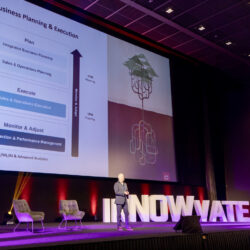S&OP: Don’t forget product pricing

For many supply chain professionals, product prices are a given – but supply chain software vendor Blue Ridge disagrees. During the SCM webinar on demand shaping held on 17 March, this newcomer to the European market explained how pricing can be used to influence both demand and supply. “In the case of a stock shortage, adjusting the price makes it possible to meet service level agreements. 90% of companies have never considered that.”
By Marcel te Lindert
Sales & operations planning (S&OP) – the ongoing process of aligning supply and demand – tops the investment list for supply chain professionals. S&OP plays a crucial role in many companies, as it brings together colleagues from supply chain and commerce to make plans together. But one factor they almost always fail to consider is product pricing. Doing so would give them valuable extra freedom, according to Maarten Baltussen from Blue Ridge: “The price affects the balance between supply and demand. If you don’t take that into account, you miss out on opportunities for optimization.”
Blue Ridge is an American vendor of supply chain software including tools for calculating price elasticity. What is the best price for a new product? When should a product be discounted? What is the best price in a promotional campaign, and how will it affect demand? “Think about scenario planning too. Should you choose a scenario that focuses on maximum sales or maximum profit? And what’s the impact on the supply chain?” said Baltussen, who is responsible for Blue Ridge’s European office which opened last year.
Dynamic pricing
Everyone who has ever booked an airline ticket or hotel room online is familiar with the concept of dynamic pricing, but it is hardly being used in retail at the moment, explained Baltussen: “I don’t know of any stores where the price varies according to what time I go shopping. But in the past year we’ve seen a significant rise in online shopping – and the competitor’s price is suddenly a lot more important in the online channel. Many retailers are monitoring that. If a competitor launches a promotion, for example, it can have consequences for their own pricing policy.”
However, that pricing policy is often aimed at maximizing sales – or rather, driving demand. But there’s no point in doing that if the supply can’t keep up. The answer, according to Baltussen, is the concept of ‘demand shaping’: “The aim is to influence the demand for a particular product in order to bring the demand in line with the planned supply. So demand shaping is different from demand management. Price is one of the factors we can use in demand shaping.”
Intelligent prediction
Thinking about prices in this way reveals new opportunities for optimization. For example, by raising the price of items that are in short supply throughout the chain, companies can decrease the demand and avoid failing to meet their service level agreements with existing customers. “90% of companies have never considered this possibility, let alone put it into practice. Price can also be used to prevent excess inventory, of course. Supply chain professionals need to realize that the price doesn’t have to be a given.”
At Blue Ridge, demand shaping starts with ‘intelligent prediction’, which goes beyond statistical forecasting. Other important elements include the ability to learn. “Suppose you want to set up the same promotion as last year. Do you just use the same forecast as last year? Or do you also check how actual sales deviated from that forecast? If you don’t use that information in your forecast for this year, you haven’t learned anything. The same goes for the circumstances, both then and now. Was there a major sporting event, for example, and what was the weather like? The software makes it possible to automatically include all that in the demand forecast.”
Science
Blue Ridge is based on new and advanced algorithms. During the webinar, Cliff Isaacson, who is responsible for product strategy at the company, explained ‘autoregressive forecasting’ and ‘neural network forecasting’ – the techniques his company deploys for fast-movers. Extra explanation was important because planners often lack confidence in a new tool, he said: “We have to prove that these tools really work – that they make life easier and allow planners to focus on exceptions. Intelligent prediction is about making better use of science to support planners.”
Isaacson added that new algorithms are needed in areas where statistical forecasting doesn’t offer a solution, i.e. for slow-movers. “It makes sense that many retailers focus on fast-movers, but it’s actually the longtail of slow-movers that is crucial for success in a lot of industries. Take spare parts or automotive components, for example. Two out of three companies struggle with those slow-movers. Why? Because it’s difficult to predict when a part will need to be replaced and therefore be ordered. You can identify seasonal patterns for fast-movers, but not for spare parts that are only sold once or twice a year.”
Intelligent minimum/maximum levels
Companies often work with demand averages for spare parts, but that usually results in them getting stuck with far too much stock. “We use a technique that we call ‘intermittent demand forecasting’. Because demand for spare parts is rarely continuous, we analyse things like the frequency with which orders come in. This generates a forecast that is 4-8% more accurate. That might not seem like much, but it can have a big impact when it comes to how much to invest in inventory.”
The next question is how companies can replenish their stock of slow-movers efficiently. This is far from simple, as many suppliers have a minimum order quantity. Blue Ridge’s solution is called the ‘intelligent min/max’. “The key is to take a smart approach to filling the truck with other items so that you avoid getting stuck with high stock levels again,” stated Isaacson. Baltussen reiterated the importance of explaining these solutions. “If the solution doesn’t explain why a specific algorithm is used, it’s the wrong solution. That’s one reason why we always indicate how reliable an outcome is. If the reliability is too low, then we must omit that outcome.”










